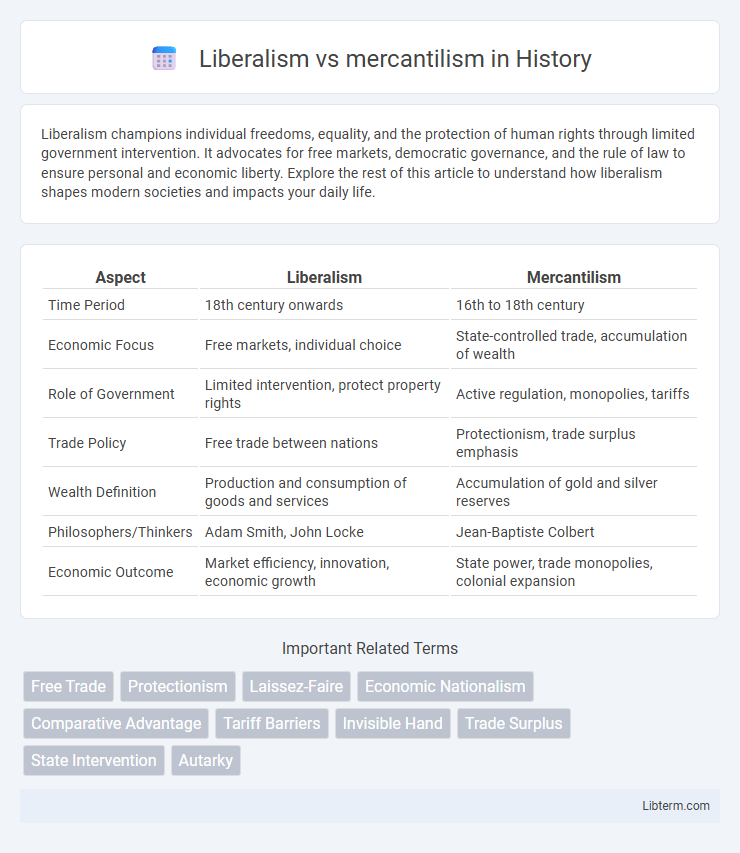Liberalism champions individual freedoms, equality, and the protection of human rights through limited government intervention. It advocates for free markets, democratic governance, and the rule of law to ensure personal and economic liberty. Explore the rest of this article to understand how liberalism shapes modern societies and impacts your daily life.
Table of Comparison
| Aspect | Liberalism | Mercantilism |
|---|---|---|
| Time Period | 18th century onwards | 16th to 18th century |
| Economic Focus | Free markets, individual choice | State-controlled trade, accumulation of wealth |
| Role of Government | Limited intervention, protect property rights | Active regulation, monopolies, tariffs |
| Trade Policy | Free trade between nations | Protectionism, trade surplus emphasis |
| Wealth Definition | Production and consumption of goods and services | Accumulation of gold and silver reserves |
| Philosophers/Thinkers | Adam Smith, John Locke | Jean-Baptiste Colbert |
| Economic Outcome | Market efficiency, innovation, economic growth | State power, trade monopolies, colonial expansion |
Introduction to Liberalism and Mercantilism
Liberalism promotes free markets, individual liberties, and minimal government intervention, emphasizing economic efficiency and open competition. Mercantilism, dominant from the 16th to 18th centuries, advocates for strong state control, accumulation of wealth through trade surpluses, and protectionist policies to enhance national power. The fundamental contrast lies in liberalism's support for free trade versus mercantilism's focus on regulated commerce and resource accumulation.
Historical Backgrounds of Both Doctrines
Liberalism emerged in the 18th century as a response to the restrictive mercantilist policies that dominated European economies, promoting free trade and individual economic freedoms as outlined by Adam Smith in "The Wealth of Nations" (1776). Mercantilism, prevalent from the 16th to 18th centuries, focused on accumulating national wealth through trade surpluses, colonial expansion, and state intervention to protect domestic industries. The shift from mercantilism to liberalism marked a fundamental change in economic thought, emphasizing market self-regulation and minimal government interference in economic activities.
Core Principles of Liberalism
Liberalism emphasizes individual freedom, free markets, and limited government intervention, advocating for open trade and competition to drive economic growth and innovation. It supports the idea that market forces, rather than state control, should determine resource allocation, promoting efficiency and consumer choice. Contrasted with mercantilism, which prioritizes government regulation and accumulating wealth through trade surpluses, liberalism champions minimal barriers to international commerce and the protection of private property rights.
Key Tenets of Mercantilism
Mercantilism centers on accumulating national wealth through a positive balance of trade by exporting more than importing, emphasizing government regulation of the economy to achieve this goal. It advocates for strong state intervention, including tariffs, subsidies, and monopolies, to protect domestic industries and maintain a favorable trade surplus. The doctrine views precious metals like gold and silver as vital indicators of national power and wealth, driving policies aimed at maximizing bullion reserves.
Economic Policies: Liberalism vs Mercantilism
Liberalism advocates for free markets, minimal government intervention, and open trade to promote economic growth and individual prosperity. Mercantilism emphasizes strong government control, protectionist policies, and the accumulation of wealth through trade surpluses and colonial expansion. While liberalism supports competition and innovation, mercantilism prioritizes national economic self-sufficiency and state power.
Trade Approaches: Free Markets vs Protectionism
Liberalism advocates for free markets where trade flows with minimal government intervention, promoting efficiency and competition globally. Mercantilism emphasizes protectionism, using tariffs, quotas, and subsidies to shield domestic industries and accumulate national wealth. These contrasting trade approaches reflect liberalism's goal of open markets versus mercantilism's focus on state-controlled economic power.
Role of Government in Economic Management
Liberalism advocates for minimal government intervention in economic management, emphasizing free markets and individual entrepreneurship as key drivers of wealth creation. In contrast, mercantilism supports strong government control, promoting policies like tariffs, subsidies, and state regulation to enhance national power and protect domestic industries. The divergent roles reflect liberalism's trust in market self-regulation versus mercantilism's preference for strategic state involvement in economic affairs.
Impact on Globalization and International Trade
Liberalism, emphasizing free markets and minimal state intervention, has driven globalization by promoting open international trade, lowering tariffs, and encouraging competitive markets that foster innovation and economic growth. In contrast, mercantilism advocates for state control, protectionism, and accumulation of wealth through trade surpluses, often leading to trade barriers, restricted market access, and limited global economic integration. The tension between these ideologies shapes trade policies, influencing global supply chains, foreign direct investment flows, and the overall expansion of international economic networks.
Pros and Cons of Each Economic Theory
Liberalism promotes free markets, encouraging competition and innovation, which often leads to economic growth and consumer choice, but it may result in income inequality and under-provision of public goods. Mercantilism emphasizes state control and accumulation of wealth through trade surpluses, enhancing national power and protecting domestic industries but can cause trade conflicts and limit market efficiency. Both theories offer distinct approaches: liberalism fosters global integration, while mercantilism prioritizes economic nationalism and self-sufficiency.
Contemporary Relevance: Liberalism vs Mercantilism Today
Contemporary liberalism emphasizes free trade, open markets, and the reduction of state intervention to promote economic efficiency and global integration. Mercantilism, while largely historical, influences modern protectionist policies and economic nationalism aimed at safeguarding domestic industries and national interests. The ongoing debate between these approaches shapes international trade agreements, tariffs, and economic strategies amid geopolitical tensions.
Liberalism Infographic

 libterm.com
libterm.com